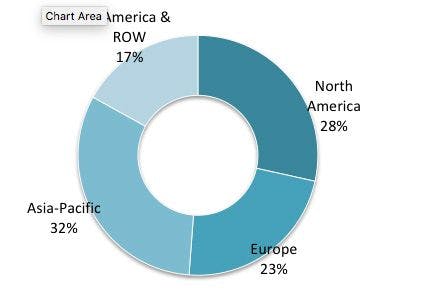Eluent Preparation for Hydrophilic Interaction Liquid Chromatography, Part II: pH, Buffers, and Gradient Elution
LCGC North America
Certain details related to mobile-phase preparation that can be assumed in reversed-phase LC separations can be much more consequential in HILIC.
When preparing buffers for hydrophilic interaction chromatography (HILIC) separations, is the buffer concentration considered relative to the aqueous portion of the eluent only, or to the aqueous–organic mixture?
In the January installment of LC Troubleshooting (1), we addressed several practical issues related to the preparation of eluents for hydrophilic interaction chromatography (HILIC) separations. We discussed how different methods of preparing eluents composed of acetonitrile and aqueous components can lead to very different retention times and selectivities, and that we can help our colleagues by providing more detail when documenting eluent preparation procedures, whether for standard operating procedures (SOPs) or journal articles. We also discussed the effects of different buffer cations (for example, Na+ and K+) on retention and selectivity in HILIC separations. In this second installment on the topic of eluent preparation for HILIC separations, we discuss some of the other practical factors to consider concerning buffers used in the aqueous component of the eluent. Here too, different methods of preparing buffers can have a significant impact on retention, selectivity, and reproducibility of HILIC separations.
Dwight Stoll
pH for HILIC Separations: Its Importance and How to Measure It
In reversed-phase liquid chromatography (LC), the pH of the eluent can significantly influence analyte retention, especially if the analyte contains one or more ionizable functional groups (2). The same is true for HILIC separations, and the effects can be even more pronounced than those in reversed-phase LC if a significant component of the retention of an analyte is dependent on electrostatic (that is, ion–ion) interactions. Figure 1 shows the impact of pH on the retention of two compounds on two different stationary phases under HILIC conditions. We see that 5-methylcytidine, which is not ionized in water at pH values below about 12, is similarly retained on the two columns, and the retention is nominally unaffected by pH. Nortriptyline, on the other hand, is much more retained on the bare silica column, and the dependence of retention on mobile-phase pH is much stronger than it is on the OH5 column. This result can be rationalized by understanding that nortriptyline is present primarily in the protonated and positively charged form in water at pH values below about 9, and that deprotonated and negatively charged silanol groups on the exposed silica surface can interact strongly with the positively charged analyte through ion–ion interactions.

Figure 1: Retention time under gradient elution conditions for 5-methylcytidine and nortriptyline on two different HILIC columns: (a) bare silica (Ascentis Express HILIC); and (b) OH5 (Ascentis Express OH5). Mobile-phase A: 100 mM ammonium acetate adjusted to wwpH 6.0 with acetic acid, 100 mM ammonium formate adjusted to wwpH 3.0 with formic acid, or 100 mM ammonium bicarbonate adjusted to wwpH 9.0 with ammonium hydroxide; mobile-phase B: acetonitrile; mobile-phase gradient: 95-80% B in 5 min with a hold for 1 min at 80% B; flow rate: 0.6 mL/min; column temperature: 35 °C.
As a practical matter, then, we are faced with the question of whether it is the pH of the aqueous buffer used in the eluent that matters, or the pH of the aqueous–organic mixture. In other words, if we are aiming to use an ammonium acetate buffer at pH 6, should we determine that pH in the aqueous component of the eluent before mixing it with acetonitrile or after mixing? The fundamental aspects underlying answers to this question have been discussed at length over the years in LCGC (3–5) and elsewhere (6). Here, we briefly review the main points, because they remain very important to the general topic of using buffers in HILIC separations.
The dissociation constants of acids (that is, pKas) in water are influenced by the presence of organic solvents like acetonitrile and methanol. The changes in pKa with the addition of different levels of acetonitrile are shown in Table I for some common buffering agents and simple analytes.
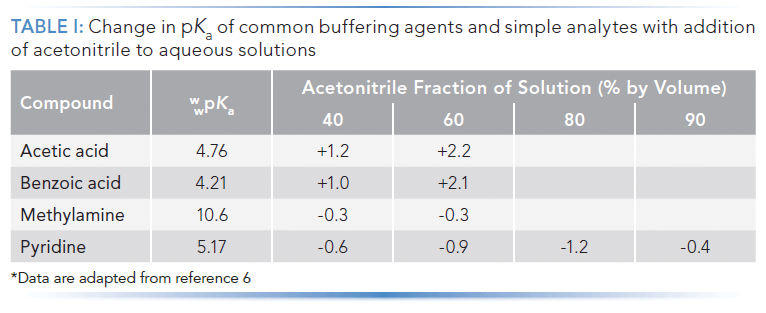
We see that for some compounds the pKa values increase upon addition of acetonitrile, meaning the compounds become less acidic, whereas for others the pKa values decrease. This differential effect on pKa that depends on the chemistry of the compound can have a significant effect on the behavior of a separation. Suppose we use an acetate buffer with a measured wwpH of 6.0 (the wwpH nomenclature means that the pH is being measured in a completely aqueous solution, and that the pH electrode has been calibrated using pH standards that are aqueous solutions), and pyridine is one of our analytes. Given that the pKa of the pyridinium ion in water is about 5.2, roughly 80% of the pyridine injected into a column containing only the acetate buffer will be present in the column as pyridine and 20% will be present as the protonated pyridinium ion. However, if we add acetonitrile to the eluent such that only 20% of the eluent is acetate buffer, the swpH (this nomenclature means that the pH is being measured in a solution containing organic solvent, while the pH standards are still in aqueous solution) will increase to about 8, whereas the pKa of the pyridinium ion will decrease to about 4. Under these conditions, virtually all of the pyridine injected into the mobile phase will be present as the deprotonated pyridine free base, which in turn will significantly affect the way the analyte interacts with the stationary and mobile phases, especially relative to other analytes. Clearly, these effects are important to HILIC separations particularly because much higher levels of acetonitrile are used in the eluent compared to what is normally used in reversed-phase LC. When possible, one should anticipate these effects during method development and decisions involving eluent pH. However, given that the change in pKa because of the organic solvent is unknown, or at least not available in the literature, for many compounds of interest, simple scouting experiments are the most reliable way to understand the impact of eluent pH on retention of an ionizable compound under HILIC conditions. As described by John Dolan in an article on buffers recently, systematic variation of the eluent pH should certainly be a part of method robustness testing to make sure that the method does not use a pH where analyte retention is sensitive to small changes in pH (2).
Now, let's come back to the question we started with: should the pH be measured in the aqueous component of the eluent, or in the aqueous–organic mixture? Our view is that measuring or even using swpH calibrants in aqueous–organic mixtures to obtain the sspH is definitely useful for mechanistic studies of HILIC retention. When swpH can be measured reproducibly it is helpful for estimating the ionization state of the analyte in the eluent. However, these steps are not necessarily required for practical work. Calibrating the pH electrode using aqueous calibrants and then measuring the pH of the aqueous buffer alone to obtain wwpH provides a useful reference point for the pH of the eluent.
Aqueous Buffers: Preparation and Impact on Retention and Selectivity
As we stated at the beginning of this series of column installments, we have been motivated to discuss the details of eluent preparation for HILIC separations in part because of the ambiguity we find in many descriptions of eluent conditions in the chromatographic literature. It is common to see a description of an eluent in the experimental section of a paper describing a HILIC separation that goes something like this: Description: 90:10 acetonitrile–buffer, with 10 mM ammonium acetate at pH 6. The problem with descriptions like these is that they are ambiguous. Assuming we are preparing 1 L of eluent, this description could reasonably lead to at least two different solutions that would be very different in composition. Case A: We could prepare 1 L of buffer by adding 10 millimoles of ammonium acetate to 900 mL of water, adjusting the wwpH to 6.0 by addition of acetic acid, and then add water to bring the buffer to a final volume of 1 L. Then, we would combine 100 mL of this buffer with 900 mL of acetonitrile to produce the 90:10 organic–aqueous eluent. Case B: In this case we could prepare 1 L of buffer by adding 100 millimoles of ammonium acetate to 900 mL of water, adjusting the wwpH to 6.0 by addition of acetic acid, and then add water to bring the buffer to a final volume of 1 L. Then, we would combine 100 mL of this buffer with 900 mL of acetonitrile to produce the 90:10 organic–aqueous eluent-the same as in Case A. Now, the eluent produced in Case A is consistent with the description in the sense that the ammonia–ammonium concentration in the buffer before adding it to the acetonitrile would be 10 mM. However, one could argue that the eluent produced in Case B is consistent with the description in the sense that after combining the aqueous buffer with the acetonitrile there will be 10 millimoles of ammonia–ammonium present in 1 L of eluent (that is, the ammonia–ammonium has been diluted by a factor of 10 by addition of the acetonitrile). Clearly, there is a difference in the properties of the eluents produced in these two cases. And, the consequences of the difference can be significant in the case of HILIC separations. Figure 2 shows the retention times obtained for neutral, acidic, and basic probe compounds on two different HILIC columns using either 10 or 100 mM ammonium acetate, wwpH 6.0 in the preparation of a 95:5 organic–aqueous eluent. We see that whereas there is very little impact of the buffer concentration on the neutral compounds inosine and guanosine, the effect on the retention of amitriptyline is most pronounced with the bare silica column. This is expected given that ion–ion interactions are expected to contribute substantially to the retention of amitriptyline under these conditions (7). We note here that these retention times were obtained under gradient elution conditions, and so the near doubling of retention time for amitriptyline is even more striking. Our point here is not that the method of eluent preparation described in Case A or B is better per se, but that the method used can have a significant impact on retention, and that descriptions of experimental conditions used for these separations should be written explicitly to avoid ambiguity.
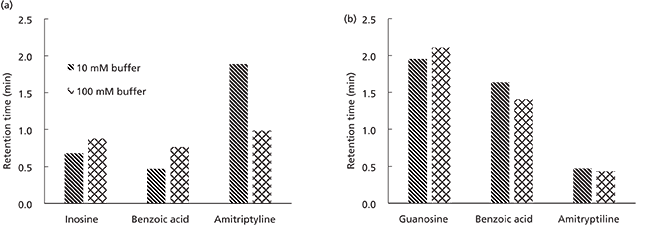
Figure 2: Retention time under gradient elution conditions for different probe compounds on (a) bare silica (Ascentis Express HILIC); and (b) OH5 (Ascentis Express OH5) HILIC columns with either 10 or 100 mM ammonium acetate, wwpH 6 buffer used in the preparation of an acetonitrile-buffer eluent. Mobile-phase A: 100 mM or 10 mM ammonium acetate, adjusted to wwpH 6.0 with acetic acid; mobile-phase B: acetonitrile; mobile-phase gradient: 95-80% B in 2.5 min for the bare silica column, and 3.27 min for the OH5 column; flow rates: 1.2 mL/min (bare silica) and 0.9 mL/min (OH5); column temperature: 35 °C.
Gradient Elution
The last topic we'd like to touch on here concerns gradient elution for HILIC separations, particularly the composition of the two solvents used in the gradient elution program. Suppose the eluent delivered to our HILIC column is nominally 90:10 acetonitrile–buffer-where the buffer alone is 100 mM in ammonium acetate-but that we would like to do gradients from more to less acetonitrile to accommodate analytes in our sample with a range of hydrophilicity. The question here is, should we prepare A and B solvents such that the ammonium acetate concentration of the eluent delivered to the column is constant over the duration of the gradient, or can we just have the ammonium acetate in the A solvent, which will result in not only an acetonitrile gradient but also an ammonium acetate gradient? Table II shows two possible scenarios that reflect this difference in operation.
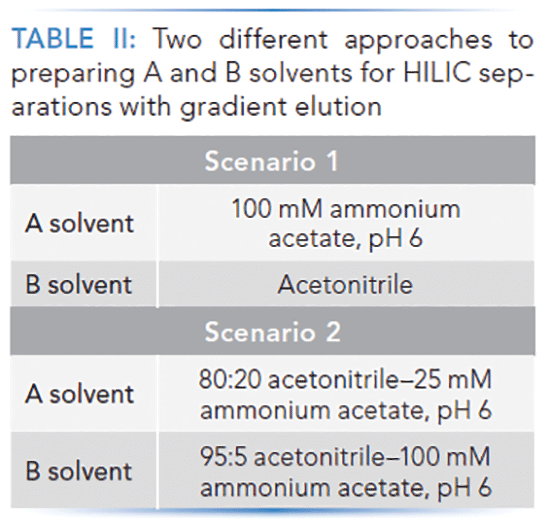
In Scenario 1, the number of moles of ammonium–ammonia per liter of eluent delivered to the column will actually increase from 5 to 20 millimoles per liter over the course of a solvent gradient program that runs from 95% to 80% B solvent. On the other hand, with Scenario 2 the ammonium acetate concentration delivered to the column stays constant at 5 millimoles per liter of eluent over a gradient that runs from 100% B to 100% A. Clearly the chemical dynamics inside the column will be much more complex in Scenario 1, but the upside of this approach is that the A and B solvents can be used very flexibly during method development. On the other hand, in Scenario 2 there are fewer mobile phase variables changing inside the column during the gradient, but making adjustments to the A and B solvents during method development is very tedious. In our own work, we have compared the repeatability of HILIC separations carried out under the two scenarios described here. Figure 3 shows three replicate gradient elution separations for each scenario. Visually it is obvious that while the two scenarios produce different retention patterns, the repeatability of each separation is really very good. With this result in hand, we most commonly do our method development work using the scheme described in Scenario 1. It is likely that this type of comparison carried out on different high performance liquid chromatography (HPLC) systems with different pump and eluent mixer designs will yield different retention patterns and different degrees of variation between the two scenarios. Understanding these differences will be especially important in situations where a method will be transferred to a laboratory running different instrumentation.
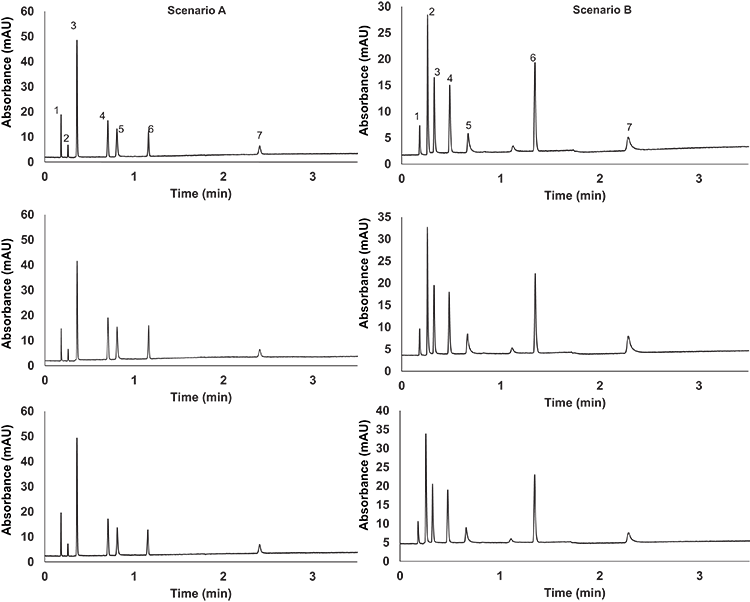
Figure 3: Representative chromatograms from replicate separations of a mixture of seven probe compounds. Note that the two conditions were run at different times and the differences in peak height are simply a result of different preparations of the sample mixture. Column: 100 mm × 2.1 mm, 2.7-µm Supelco Ascentis Express HILIC. Scenario 1: mobile-phase A: 100 mM ammonium acetate at pH 6 adjusted to wwpH 6.0 with acetic acid; mobile-phase B: acetonitrile; mobile-phase gradient: 95-80% B in 2.5 min; flow rate: 1.2 mL/min; column temperature: 35 °C. Scenario 2: mobile-phase A: 5:95 (v/v) 100 mM ammonium acetate, wwpH 6-acetonitrile; mobile-phase B: 20:80 (v/v) 25 mM ammonium acetate wwpH 6-acetonitrile; mobile-phase gradient: 0-100% B in 2.5 min; flow rate: 1.2 mL/min; oven temperature: 35 °C. Peaks: 1 = acenaphtalene, 2 = pyridine, 3 = deoxyuridine, 4 = benzoic acid, 5 = inosine, 6 = amitriptyline, 7 = methylguanosine.
Summary
Some details related to mobile phase preparation that can be assumed or taken for granted in reversed-phase LC separations with little consequence can be much more consequential in HILIC separations. In many cases there is no single "right" answer, but we think data of the type shown here can inform the adoption of a set of best practices that will make method development for HILIC separations more robust, simple, and repeatable. We close by reiterating the suggestion of Tindall that no matter what method of buffer preparation is used for your HILIC separation, be sure to describe your work using a complete, unambiguous description of how exactly the buffer was prepared so that others can reproduce the results of your work (5).
Acknowledgments
The columns used to obtain the data shown here were provided by Dave Bell at MilliporeSigma. C. Seidl acknowledges support from the São Paulo Research Foundation - FAPESP - Process number 2016/02941-5 for her contributions to this article.
References
(1) C.A. Lucy, C.B. Craven, C. Seidl, and D.R. Stoll, LCGC North Am. 36(1), 18–24 (2018).
(2) J.W. Dolan, LCGC North Am. 35(1), 22–28 (2017).
(3) G.W. Tindall, LCGC North Am. 20(11), 1028–1032 (2002).
(4) G.W. Tindall, LCGC North Am. 20(12), 1114–1118 (2002).
(5) G.W. Tindall, LCGC North Am. 21(1), 28–32 (2003).
(6) M. Rosés, J. Chromatogr. A 1037, 283–298 (2004). doi:10.1016/j.chroma.2003.12.063.
(7) A. Kumar, J.C. Heaton, and D.V. McCalley, J. Chromatogr. A 1276, 33–46 (2013). doi:10.1016/j.chroma.2012.12.037.
ABOUT THE AUTHORS
Dwight Stoll

Dwight Stoll is the editor of "LC Troubleshooting." Stoll is an associate professor and co-chair of chemistry at Gustavus Adolphus College in St. Peter, Minnesota. His primary research focus is on the development of 2D-LC for both targeted and untargeted analyses. He has authored or coauthored more than 50 peer-reviewed publications and three book chapters in separation science and more than 100 conference presentations. He is also a member of LCGC's editorial advisory board. Direct correspondence to: LCGCedit@ubm.com
Claudia Seidl

Claudia Seidlis a postdoctoral fellow in the Chemistry Department at the University of São Paulo, Brazil. She developed a study focused on column re-equilibration in HILIC under Professor Dwight R. Stoll's supervision while she was a visiting postdoctoral fellow at Gustavus Adolphus College, in St. Peter, Minnesota.
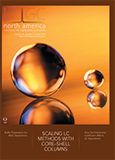
Polysorbate Quantification and Degradation Analysis via LC and Charged Aerosol Detection
April 9th 2025Scientists from ThermoFisher Scientific published a review article in the Journal of Chromatography A that provided an overview of HPLC analysis using charged aerosol detection can help with polysorbate quantification.
Removing Double-Stranded RNA Impurities Using Chromatography
April 8th 2025Researchers from Agency for Science, Technology and Research in Singapore recently published a review article exploring how chromatography can be used to remove double-stranded RNA impurities during mRNA therapeutics production.
Troubleshooting Everywhere! An Assortment of Topics from Pittcon 2025
April 5th 2025In this installment of “LC Troubleshooting,” Dwight Stoll touches on highlights from Pittcon 2025 talks, as well as troubleshooting advice distilled from a lifetime of work in separation science by LCGC Award winner Christopher Pohl.
Study Explores Thin-Film Extraction of Biogenic Amines via HPLC-MS/MS
March 27th 2025Scientists from Tabriz University and the University of Tabriz explored cellulose acetate-UiO-66-COOH as an affordable coating sorbent for thin film extraction of biogenic amines from cheese and alcohol-free beverages using HPLC-MS/MS.

